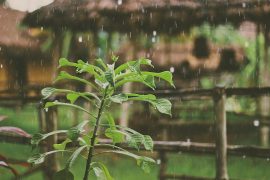What Is Rainwater Harvesting?
This is a term used for collecting and storing rainwater from rooftops or other surfaces and using it to boost the supply of fresh water. In many cases, water is collected for use as a non-potable source of water for toilet flushing, urinals, and irrigation. If the water happens to be treated it can be used as potable water for drinking, washing dishes, or for bathing. As the treatment for this water is quite expensive, most rainwater harvesting systems in urban settings are not set up to provide drinking water.
A rainwater harvesting system is made up of gutters or conduits that transport rainwater from a given area such as the roof or a paved area to cistern storage and then used at a later date.
If the water exceeds the cistern capacity, it can be sent to a soakaway or vegetated area for groundwater recharge or to municipal sewers.
The Advantage Of Using Rainwater To Meet Needed Supplies
The potential for rainwater harvesting and management to reduce the consumption of water, alleviate stormwater runoff, and offer drinking water has been mostly overlooked in this day and age. In some cases, this is caused by seasonal changes in rainfall, the cost for storage, the treatment and retrofitting of the water systems, and as a policy and institutional barrier. On top of that, water management policies seem to be short-sighted and the over-exploitation of river water and groundwater can get out of control.
In many cities and communities, people becoming educated and realizing the long-term benefits from alternative water sources, including rainwater, is more important than ever. The limited distribution of rainwater harvesting and management (RWHM) needs the involvement and cooperation of communities that are the most affected. A city with knowledge about water sources requires communities that understand the benefits of various systems such as the rainwater system.
People Want The Rainwater Harvesting System But Why?
The rainwater harvesting system is one of the very best practices and supports the conservation of water. In this day and age, we have a huge shortage of good quality water which is becoming a major concern. Rainwater that is pure and good-quality can be used in so many ways including irrigation, bathing, washing, cleaning, cooking, and providing good water for livestock.
How Do I Know How Much Rainwater I Should Collect?
To calculate how much rain your roof catches, multiply your home’s width by its length (in feet) to estimate its footprint. Now, estimate the portion of this area that drains to the downspout you will use to catch the rain.
The Formula –
Rain caught (in gallons) = inches of rain x 0.6* x
(the portion of building footprint)
*One-inch of rain falling on a sq. ft of the surface will yield around 0.6 gallons of water.
This formula will give you a rough idea of how much rainwater you should catch.
As an example – if your home is 1,400 sq ft and you want to know the amount of water that comes from a 1/4-inch (25”) rain event:
Rain caught in gallons = (25) x (6) x (1,400) = 210 gallons. It can be less if you are only collecting from one specific area of the roof.
On the other hand, storage is limited to the capacity of your system. Having added capacity will help your system get through dry spells but most homes do not have room to store thousands of gallons of water for their use in landscape irrigation throughout a dry summer. On top of that, if you have a large cistern, it will take a very long time to pay back.
The capacity and cost are directly related. You must decide what you should spend on storage. Natural Yard Care practices such as building soil with compost and mulching, you should have low-water-use plants, and Smart Watering practices which will give you shorter paybacks and grow healthier lawns and gardens.
How Capture, Store, And Reuse Works
The most simple rainwater harvesting system includes a way to collect the rain, a way to direct the water such as a gutter or downspout, and a place to store the water, like a barrel. Unfortunately, because the system is so basic, you will not have proper filtration or storage. A simple system is good for watering a garden, putting out a fire, or as greywater such as toilet bowl water.
Having a better system will give you more uses for the water including a collection system and several layers of filters to keep debris and dirt out of the water supply.
A good storage tank should have the ability to safely handle overflow water and is made of materials that will not leach into the water and inhibit bacterial growth. The container should be hooked to a control system that will continue to filter the water for drinking and purity, or at least to monitor and track the water level. The system would need a pump to direct the water, a flow meter, and a backflow prevention system. All of these components would have to be hooked up to a power source.
